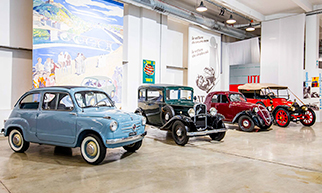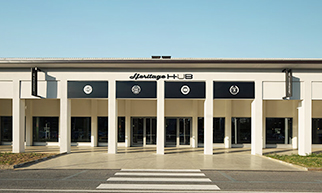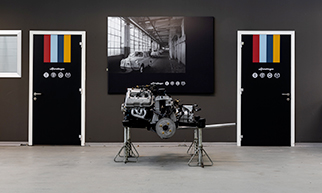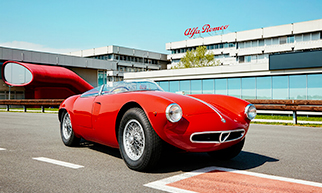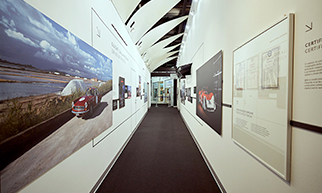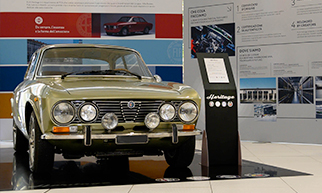As well as mufflers, tuning kits and the conversion of production cars into thoroughbred sports cars, Abarth also produced single-seaters. From the futuristic bodies by Pinin Farina and Bertone to Formula cars, they proved to be successful in giving visibility to the Scorpion brand by breaking speed and endurance records, but also in acceleration over short distances.
In the mid-1950s, Carlo Abarth was increasingly convinced that, to promote his cars, as well as maintaining a presence on racetracks, that it would have a great impact on the world to break speed and endurance records. According to the same approach, he also helped Fiat to demonstrate the qualities and robustness of the New Fiat 500, which had initially caused consternation among the public and the specialist press.
The ideal stage for these exploits was the Monza racetrack complex, with its very fast “high-speed ring”, a track where cars could travel for hours and hours at full throttle, stopping only to refuel and change drivers. It was in this context that Abarth cars broke a long series of records: from the Fiat Abarth 750 Record to the Fiat 500 Elaborazione Abarth, but also the futuristic aerodynamic closed-wheel single-seater created in conjunction with the most authoritative Italian coachbuilders at that time.
As well as record-breaking prototypes and conversions of mass-production cars such as the Fiat 600, for its team and private clients Abarth also produced cars dedicated to track competitions and hillclimb races, both with closed wheels, barchettas in the Sport category, and even open-wheel single-seaters such as Formula. The chassis of these racing cars were created by engineer Mario Colucci, who arrived in Turin in 1958 from Alfa Romeo, for the Alfa Romeo Abarth 1000 project.
In late 1964, the Fédération Internationale de l'Automobile (FIA) set new records over very short distances. At the same time, the Scorpion brand’s cars’ overall record count stood close to 100.
It was the year 1965: Carlo Abarth was 57 years old but he still wanted to be a major player at this historic moment for his company. He therefore selected a lightweight, snappy open-wheel single-seater: codenamed SE 08, created in 1964 as a Formula 2 with a 1.3-litre engine based on a Simca, transformed into a Formula 3 with the more reliable 1000, originally the Fiat 600 in the Abarth 1000 Berlina “Corsa”. The single-seater was used in 1964 for hillclimb races. A few changes to the nose and windshield to improve aerodynamics – lightness on the one hand (it weighed approximately 500 kg) and an output of over 100 hp on the other – made the car perfect for taking the newly founded acceleration records.
As Carlo Abarth wanted to drive this car himself, he subjected himself to a strict diet and on 20 October 1965, as per tradition on the Monza track, he beat two world records in Class G, setting acceleration records on the quarter-mile and 500 metres. Having reached 100 the following day on the same chassis, Abarth had the two-litre engine fitted to set two more records, in the E-Class, over the same distances. The following year, the single-seater returned to the track again at Monza to retake the records the Germans had tried to undermine.
The evolution of Abarth single-seaters saw Fiat play a leading role on the one hand, initially unofficially, and on the other the CSAI body that created a single-brand trophy at a low cost, for young drivers to train, grow and emerge. That formed the genesis of Formula Italia, and later Formula Fiat-Abarth.
After the record-breaking experience, the creation of Formula cars at Abarth continued with new intentions. In 1971 under the code name SE 024, the Scorpion brand attempted to put together a car for a project of the CSAI (Italian Automobile Sports Commission, now ACI Sport), whose aim was to create an economical single-seater with a 500-cc engine, for a car and a trophy that would serve as preparation for Formula 3 and could be used to train young drivers. Although the project faded away, it became the basis for something better.
With the unofficial support of Fiat, the Trofeo Formula Italia was presented by CSAI in July 1971, thus defining the technical aspects of the cars designed and produced at Abarth with the code SE 025, but was known to all as Formula Italia.
The single-seater, built with the intention of keeping production costs low, used the glorious 1.6-litre Lampredi twin-cam that had been fitted to the Fiat 124 Sport, with brakes, rims, shock absorbers, axle shafts, steering gears and various components pinched from several Fiat production cars, whereas the five-speed gearbox is taken from the Lancia Fulvia. With two 40 Weber double-barrel carburettors, the engine delivered between 110 and 120 hp, with a weight of approximately 470 kg to take the single-seater to a top speed of over 200 km/h. The first car in the colours of the Italian flag was exhibited at the Turin Motor Show in autumn 1971, to launch the Trofeo the following year.
In year 1, the Trofeo took place in summer, as ten races at the Monza, Misano Adriatico, Imola, Vallelunga and Varano Melegari circuits, all in Italy. Eight editions followed, producing drivers who would later move on into higher categories. The first year was won by the young Giorgio Francia, who would become one of Alfa Romeo's most authoritative test drivers as well as one of the stars of the glorious victory, together with Larini and Nannini, at the Germans’ home track in their 1993 DTM, with the legendary Alfa Romeo 155 2.5 V6 TI. Conversely, many others drivers scaled the various open-wheel categories until they reached Formula 1, including Giancarlo Martini, Pier Carlo Ghinzani, Riccardo Patrese, Bruno Giacomelli, Nicola Larini, Michele Alboreto and Siegfried Stohr.
In 1978, Fiat managed to promote the evolution of the single-brand trophy first-hand. The new car was more robust and heavier, but even more suitable for training the drivers' sensitivity in the tuning of the chassis. The Lampredi twin-cam rose to two litres and was taken from the Lancia Beta, as was the gearbox. The car was unveiled at the Monza racetrack in September 1979 during the Italian Grand Prix, one day before a Ferrari driven by Jody Scheckter returned to victory in the Drivers' World Championship. The then-test driver Giorgio Pianta – later the Alfa Romeo manager on the track as well as the designer of the highly original Lancia Trevi Bimotore – took the new Formula Fiat-Abarth (code SE 033) to the Brianza circuit.
The renewed Trofeo, with the same purpose as previously, brought out new talents, including Alessandro Nannini and Emanuele Pirro. A car was given to the management of the weekly AutoSprint, which took it to the track with the emerging driver Roberto Ravaglia, who went on to become a major star in the world of Touring cars. The gender quota came into its own for Giovanna Amati who, having later moved from Formula 3 to Formula 3000, remains the last Italian driver to race in Formula 1.
The Trofeo Fiat-Abarth ended in 1986, the year in which Alfa Romeo joined the Fiat Group, and the baton was passed in 1988 to the Formula Alfa Boxer, an open-wheel evolution of the Trofeo Alfasud, created to promote the new Alfa Romeo compact car produced at Pomigliano d'Arco.
The success of the two trophies was measured over the years by the sizeable contingent of Italian drivers in Formula 1: for over a decade, in the top divisions of motorsport on the track, there was a proliferation of Italian talents, something that would never again be repeated. There was a very similar situation in rallies with the Trofeo A112 Abarth, producing world-class drivers; even in this case, the Fiat Group played a leading role.
